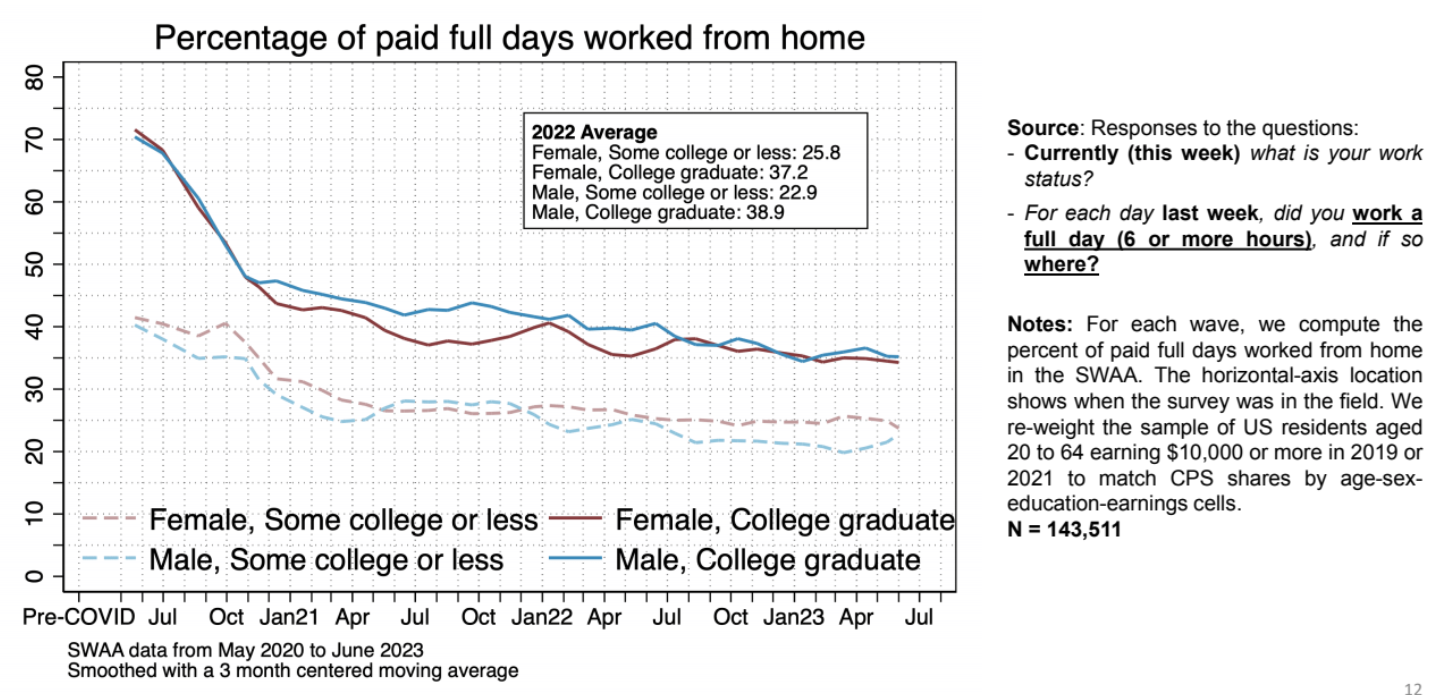It took firms decades to adjust to electricity by redesigning factories, products, and workflows to take full advantage of the new possibilities. Similarly, the benefits of work from home start to come most profoundly when expensive offices can be shrunk, employers can draw from a much larger pool of workers and workers can adjust when and where they work, including the location of their homes. It’s not surprising, therefore, that with little time for either the workers or the firms to adjust and with few options to choose how much to work from home, productivity fell when COVID sent workers home. But, with more time to plan and more options for hybrid but extensive work (e.g. work from home Mondays and Fridays), work from home has large benefits. We are also seeing management redesign to take advantage of work from home in the same way we saw factory redesign to take advantage of electricity. Management, for example, is shifting from input metrics–do you show up?–to output metrics–did the work get done? Designing and validating new metrics takes time, but these changes are helping to increase the benefits of work from home.
Nick Bloom reviews the evidence (slides here).
Looking at micro economic studies on working from home productivity, the classic is “The Stanford Study” I helped oversee in 2010-2012. We randomized 250 employees in a large multinational firm into those who would work from home and those who would report to the office. The expectation, of course, was that home-based employees would goof-off, sleeping or watching TV rather than working.
So, we were shocked to find a massive 13 percent increase in productivity.
The productivity boost came from two sources. First, remote employees worked 9 percent more in minutes per day. They were rarely late to work, spent less time gossiping and chatting with colleagues, and took shorter lunch breaks and fewer sick days. Remote employees also had 4 percent more output per minute. They told us it’s quieter at home. The office was so noisy many of them struggled to concentrate.
The macro evidence also suggests or at least is consistent with work from home working:
In the five years before the pandemic, U.S. labor productivity growth was 1.2 percent; since 2020, this picked up to 1.5 percent. Given the state of the world, that acceleration was miraculous.
What could have caused this? Perhaps rising government expenditure and easy monetary policy? Possibly, but greater government activity traditionally is associated with lower, not higher, productivity growth. Perhaps an acceleration in technology and computerization? Possibly, but the pandemic did not witness any pickup in technological progress. Perhaps the five-fold surge in working from home post-pandemic. Maybe cutting billions of commuting hours, replacing millions of business trips with Zoom meetings, increasing the labor supply of Americans with disabilities or child-care commitments, and saving millions of square feet of office space increased productivity? It is honestly hard to say.
Revealed preference is the most telling piece of evidence. Workers value the option to work from home and many firms now advertise the options for hybrid work as a benefit:
…millions of firms around the world are adopting hybrid and remote work, there has to be something there. I have spoken to many hundreds of managers and firms over the last three years and I repeatedly hear they use home working as a key part of their recruitment and retention strategy. Indeed, another recent experiment on 1600 employees found hybrid reduced employee quit rates by 35 percent. \
Despite a rocky start, work from home appears to have stabilized at around 25% of work days overall and stunningly, nearly 40% of work days for college educated workers! Work from home thus appears to be a permanent and beneficial change in how work is structured.

The post Work From Home Works appeared first on Marginal REVOLUTION.

Comments
Post a Comment